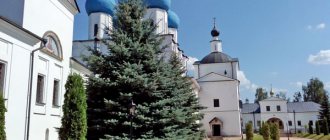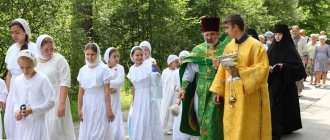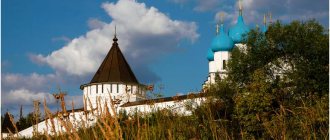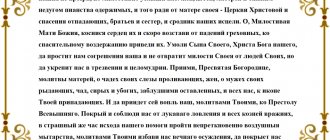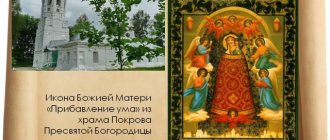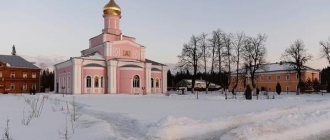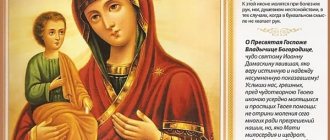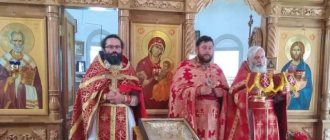To make a pilgrimage, to feel grace, to touch the miracles that the Lord generously gives us, it is not necessary to go to distant lands - to Palestine, Israel, Turkey, Georgia and other countries. Since ancient times, Russia has been considered overshadowed by the special grace of the Almighty, and holy, miraculous places, monasteries, and icons have been shown to us in abundance.
Vysotsky Monastery
Not far from Moscow, on the outskirts of the ancient city of Serpukhov, on the high bank of the river stands
majestic monastery. From a distance you can see the white stone walls and towers of the Vysotsky Monastery, the heads of the cathedrals directed towards the sky, towering over the river and the surrounding area. The Serpukhov Monastery is considered one of the most ancient not only in the Moscow region, but throughout Russia. It is one of the nine monasteries founded on Russian soil with the blessing of Sergius of Radonezh himself.
Construction was started by Prince Vladimir the Brave, the closest associate and brother of the blessed Prince Dmitry Donskoy.
At his request, Sergius of Radonezh himself chose a place for the future monastery - on a beautiful hill called “Vysokoe”. The Vysotsky Monastery in Serpukhov began to be called by the name of the place. Having said a prayer at the site chosen for the construction of the future monastery courtyard, the Monk Sergius left, leaving his disciple Athanasius to conduct the construction. He also headed the newly built monastery.
In 1991, Archimandrite Joseph became the rector of the monastery, which was opened after many years of decline and persecution of religion during Soviet times. Through his efforts, the service of the miraculous icon, revered in this area, was resumed in the temple. A new image of the Inexhaustible Chalice, to replace the missing one, was painted by Alexander Sokolov, a famous icon painter. Lists of her are now distributed in Russia and around the world. Many of them are also known for the miracle of myrrh flow.
Cafe
There is a cafe at the entrance to the monastery. Here you can drink coffee or tea and try monastic pastries. Very tasty and inexpensive.
Inexhaustible Chalice
The Vysotsky Monastery, where the miraculous icon of the Inexhaustible Chalice is now kept, was not originally the place where it was found and venerated. From the moment of its appearance until Soviet times, the image was kept in the Vvedensky convent, also located in Serpukhov.
The appearance of the Inexhaustible Chalice dates back to 1878. Then the former soldier had a dream - a schema-monk appeared to him, who ordered him to go from the Tula province, where he lived, to Serpukhov to pray to the image of the Mother of God “The Inexhaustible Chalice”. The former soldier was a drunkard who reached such an extent that he drank away all his property, and even lost his health - he became legless. The schema-monk appeared to him three times, after which the exhausted cripple crawled as best he could in the direction indicated by the elder. But, having reached the indicated monastery, he did not find the image named by the elder. They could not immediately find it, hanging in the passage from the cathedral to the sacristy. The icon actually depicted a cup, and in one of the faces the former soldier recognized the schema-monk who appeared in dreams.
Having held a prayer service in front of the newly acquired icon, the sufferer received not only deliverance from alcohol addiction, but also physical healing, and the fame of the miraculous icon began to spread throughout the city and far beyond its borders. Those obsessed with the sin of drunkenness and members of their families, who wanted healing from a terrible illness, sought the Inexhaustible Chalice. Many people returned to the temple again to give thanks for the miracle of healing that had happened.
The Inexhaustible Chalice was surrounded with special veneration in Serpukhov, where it was located. A temperance society was founded at the central church of the city, prayers were held, akathists were read, and conversations about morality were held.
Pilgrims
Pilgrims (men) can stay at the monastery for three days. For every day, a pilgrim must donate 280 rubles to the monastery, for which he can spend the night here, have lunch and dinner. If you want to stay longer, you must receive the blessing of the dean, after which you become a worker. The worker does not donate money, but is obliged to work in the monastery. The work is his donation to the monastery. Read more on the monastery website – www.visotskymonastir.ru
Losing and regaining an icon
The post-revolutionary persecution of the church greatly affected Serpukhov near Moscow. The Vladychny Monastery was closed. When it was closed, the miraculous icon was moved to St. Nicholas Cathedral, which was later also closed, and all the shrines were taken out and burned. The revealed miraculous icon and the copies from it disappeared.
The restoration of churches and monasteries in Serpukhov revived the memory of the icon revered here. In the re-opened Vysotsky Monastery in 1991, prayer services to the image began. Unfortunately, the prototype of the icon was never found - a new one was painted in 1992, now known to the entire Orthodox world.
According to iconography, the Inexhaustible Chalice icon is classified as the oldest type of depiction of a human figure (saints, martyrs, the Mother of God) on the “Oranta” icons (from the Latin “Prayer”). The Mother of God is depicted in the traditional pose of intercessory prayer - with her arms raised up and outstretched.
In terms of iconographic and plot content, it is noted that it is close to another miraculous image - the Nicene Icon, which became famous at the beginning of the 4th century AD. The blessing baby Christ on the icon is depicted standing in a bowl, and the Mother of God with her hands raised up, praying for all sinners and inviting them, instead of base passions, to fall to the source of consolation and pure spiritual joy.
Description of the architecture
All the buildings of the monastery are striking examples of architectural traditions from different centuries.
In the center of the monastery courtyard stands the beautiful Conception Cathedral, built in the architectural style of the 14th century. It is surrounded by vaulted galleries. At the end of the gallery there is a small church of the Nativity of the Virgin Mary.
Interior of the Cathedral of St. Nicholas the Wonderworker in the Vysotsky Monastery
Near the cathedral there is another church with a former refectory - Pokrovskaya, which was rebuilt more than once. But her style is recognizable as Moscow Baroque. This temple, at one time, was patronized by the Naryshkins, representatives of the royal nobility.
The temple in honor of the Three Saints stands outside the monastery fence. It contains elements of pseudo-Byzantine and pseudo-Romanesque style. The building is currently being restored. The Temple of St. Sergius of Radonezh is located in the southern part, if we take the Conception Cathedral as a guide. Its decoration has not survived to this day, but it was re-painted and underwent reconstruction.
Pilgrimage to the Inexhaustible Chalice
The question of how to get from Moscow to Serpukhov will not cause difficulties even for people who are not burdened with travel experience; the distance is small and the entire journey will take no more than 2.5 -3 hours one way:
- By car - from the Moscow Ring Road, turn onto the M2 highway (Crimea highway) and get to Serpukhov. The monastery is located on the outskirts of the city, near the banks of the Nara River. To get to it, turn right from the central square and follow 2nd Moskovskaya Street until you turn onto Bolshoy Vysotsky Lane. It will lead you straight to the walls of the monastery.
- By train to the station. Serpukhov can be reached from Tsaritsyno or from Kursky Station. From the station take bus No. 20 to the “Vysotsky Monastery” stop.
- By bus No. 458 to Serpukhov or No. 363 to Protvino from Yuzhnaya metro station. From the bus station take local bus No. 20 to the Vysotsky Monastery stop.
But it is better to visit the Serpukhov Monastery and venerate the miraculous icon during an organized trip with the pilgrimage service of Tobias. Our service was created to ensure the safety and comfort of pilgrims who decide to visit holy places
Russia, near and far abroad, we offer:
- travel on comfortable buses;
- accompaniment of an Orthodox guide;
- program that takes into account all the features of pilgrimage trips.
If you are undertaking a pilgrimage for the first time, a trip with the Tobias pilgrimage service will open up the world of spiritual travel for you and will help you create a special prayerful mood that allows you to feel all the grace that descends on a person when worshiping holy places. The Orthodox guide will answer all questions that arise and provide the necessary support. Those who have already been on pilgrimage trips will appreciate the convenience and comfort, the atmosphere of a true Orthodox journey maintained during trips.
During a one-day trip you will be able to:
- visit the Vysotsky Monastery and touch its shrines;
- defend a prayer service at the icon of the Inexhaustible Chalice, ask for a miracle of healing from addiction to alcohol (drug addiction, smoking) for yourself and your loved ones;
- visit with a tour the Vvedensky Convent - the place where the prototype of the miraculous icon of the Inexhaustible Chalice appeared;
- venerate the relics of St. Varlaam of Serpukhov;
- touch the grace of myrrh-streaming icons,
- visit the 16th century monastery - Ascension David's Hermitage;
To take part in our trips, reserve a place using the form on the website or contact us by phone.
To main
Serpukhov Vvedensky Vladychny Convent Diocesan monasteries of the Russian Orthodox Church
Information about the Vvedensky Cathedral (from the historical description of V.A. Rozhdestvensky)
The original temple of the monastery, mentioned in the chronicle, was built according to special instructions from above, in the name of the Most Holy Theotokos, in honor of Her glorious Entry into the temple. This is how the chronicle tells about it: the Monk Varlaam, when he was admonished by Saint Alexis to build a monastery, fell to the ground unconscious (“fell from death”), and in this state he saw in a vision “Angels holding the monastery, and Zechariah standing at the church door, and the Mother of God with her relatives entering; Zacharias received Yu, the Mother of God, and placed Yu in the third degree.” Rev. Varlaam, who had hitherto been greatly embarrassed by the thought of his unworthiness and inability to properly fulfill the important assignment of his saint, who wondered how he would build a temple and monastery “befitting the name of the Lady of Heaven, and also the memory of the Archpastor,” this vision, without a doubt, was not only comforted, encouraged and strengthened, but from it he had to understand that the Mother of God Herself was blessing him to build a temple and monastery, and precisely in honor of Her Entry into the temple. The vision showed the builder that even the Angels would help him in the work of building the temple and maintaining the monastery, that in this temple the Lady of Heaven herself would abide just as she once did in the temple of Jerusalem, into which she was led by her parents. “The monastery will be called Master,” said the Venerable himself. Varlaam, before he saw the Lady, and Toya became providence.” With reverent awe, the humble Varlaam kept this vision in his heart throughout his entire life, and he asked his Saint himself not to worry about it until his death: “pray, but do not force me to tell you, until death, but at death I will tell you.” And then, even in his dying moments, he refused to “tell about the vision in words, since it would be scary.” Since, in his old age, he had already lost his sight, so that the vision would not remain unknown to subsequent births, he miraculously received insight, and, illuminated by a “great light,” he told the vision “in ink and a reed on the charter,” which were brought by the deacon Saint. And the memory of the appearance of the Mother of God by St. Varlaam did not die away with his death. According to the will of the Rev., “who commanded that writing to be preserved in memory of his name,” it was passed down with reverent love from generation to generation, for five centuries, and without a doubt, it always served as a great consolation, edification and encouragement to excel in monastic deeds for those praying in the temple. and those who labor in the monastery.
Originally Rev. Varlaam built a wooden temple. But, soon, the special desire of Saint Alexy to build a most splendid church for the glory of the Mother of God and, perhaps, his rich offerings moved the reverend. Varlaam for new work - the construction of a stone temple, which in 1362, as stated in the chronicle, was already “composed.” The stone cathedral church that now exists in the monastery must be the same one that was built by the Rev. Varlaam and was consecrated by Saint Alexy himself. The architecture of this ancient building represents the character of the 14th century. Of course, five centuries of existence could not help but transform the appearance of the temple - so, due to dilapidation, the chapters on it were changed; According to the needs of the church at different times, as we see below, extensions were made to it on three sides. But the basic structure of the cathedral and its internal appearance have remained almost unchanged. It has the shape of a square, is built of large bricks, and the outside is lined with white stone; layers of wide walls are fastened with iron ties. Tradition says that the white stone for the construction of this temple was taken not far from the monastery, on the flood meadows that now belong to the city society, from the place where a small lake was subsequently formed, hitherto called “Stone”. In the interior of the temple there are two supporting tetrahedral pillars connected at the top by an arch; similar arches are thrown from the pillars and to all four walls (including the pre-altar - stone). Cross braces are stretched under the arches. In the corners of the cathedral, at the top, as well as at the base of the lantern and in the altar, there are up to 20 voice boxes. The lantern is through, in two tiers, each with special windows; its lower tier is wider than the upper one, and therefore has a semicircular slope at the top, covered with iron. The other (four) chapters have a similar appearance from the outside. The walls of the cathedral, outside and in the middle, are surrounded by a double belt of white stone; All three entrance doors have archivolts - also made of white stone. The holy altar, rising from the church platform by two steps, is divided by capital walls into three parts, which protrude to the east in semicircles; Between these semicircles, flat semi-columns made of white stone are inserted from the outside. In a high place, in the window, there is a stone seat, in the style of a bishop's, apparently contemporary with the foundation of the cathedral. The founder of the monastery himself, who consecrated the temple, St. Alexy, probably once sat on it. In the altar wall, near the southern doors, there is a small tent (3 and 11/2 arches), probably the “cathedral pantry” in which, according to the monastery inventories, consumable books, money, etc. were kept.
The pre-altar iconostasis is recent; no traces of the original wall writings remained; but the holy icons in the iconostasis are all ancient, dating back to the 14th century. The current iconostasis consists of four belts. On the royal doors there are ancient icons of the four Evangelists with images of symbols: Matthew has a man, Mark has an eagle, Luke has a calf, John has a lion, all the symbols are red, with wings and with the Gospels; above the Evangelists - the Annunciation of the Blessed Virgin Mary. The local icons are as follows: the Lord Almighty, with those present, the measure is 2 arsh. 3 inches, 1 arsh wide. 8 tops; temple icon of the Presentation of the Mother of God (it will be discussed below); The Life-Giving Trinity, in the form of three Angels, recorded in the inventory of 1649, with a measure of 1 arsh. 131/2 tops, width. 1 arsh. 8 tops; Smolensk Icon of the Mother of God, 1 arsh. 111/2 tops, width. 1 arsh. 31/2 tops All local icons are in a gilded silver frame, with the same crowns decorated with multi-colored stones; the frame and decorations on three of them (except for the temple) were arranged in the same way in recent times by benefactors, Serpukhov merchants Andronik and Feodor Andreev Solodovnikov. In the second belt: above the royal doors there is a fold; on the sides there are icons of the twelve feasts, namely: to the north side - the Holy Trinity, in the form of three Angels, the Resurrection of Christ, the Entry into Jerusalem and the Resurrection of Lazarus; to the south: the Ascension of the Lord, the Transfiguration, the Annunciation and the Dormition of the Mother of God - all in 1 arsh., width. 12 vers. In the third belt, in the middle, is the Lord Almighty, sitting on the throne with the Gospel revealed in the words: Come to Me, all you who labor and are heavy laden, and I will give you rest. Take My yoke on you and learn from Me - the measure is 21/4 arsh., the width is 2 arsh.; on the sides, in a special frame, the upcoming ones are the Mother of God and John the Baptist; behind the icon of the Mother of God are icons: Archangel Michael, Apostle. Peter and Basil the Great; behind the icon of the Forerunner: Archangel Gabriel, Apostle. Paul and St. Nicholas the Wonderworker, all with a measure of 21/4 arsh., a width of 12 arsh. In the fourth belt, in the middle, is the Pechersk Icon of the Mother of God, measuring 2 arsh. lat. 11/4 arch., to the north side: pror. David, with a scroll: If you do not open, my prophecy will come true; prophet Elijah - Jealous and jealous of the Lord God Almighty; prophet Moses - I saw you in the bush in Sinia; prophet Jacob - In the form of a ladder established on the ground by hedgehogs; to the south side: King Solomon - Wisdom……. establish the temple; prophet Jeremiah - Behold, our God will not be imputed to anyone else; prophet Daniel - You saw a mountain from a stone that was not cut off; prophet Jonah - I cried out in my sorrow to the Lord my God - all in the measure of 2 arsh. in width 14 vershoks.
Initially, this temple, one must think, did not have a meal (narthex). At the entrance to the real temple, a large iron chain has survived to this day - from one pier to another, with which the door was sealed, and the door itself is constructed in the same way as the external side doors, folded, with a large internal lock and lock, it is clearly visible that this entrance was at the beginning was external. This conclusion is also led by the fact that the builder of the temple, Rev. Varlaam, as the chronicle says, “was buried in the church porch.” His grave is located near the very entrance to the actual cathedral church, where there was probably at first a porch, which was later replaced by a meal. Rev. Barlaam was buried here according to his special will: “Before he himself once said: bury me so that the Church of the Pr. Mother of God." Apparently, the zealous temple builder during his lifetime put in so much care and labor to build a temple for the glory of the Mother of God, which was pleasing to Her, and until his death he never lacked in zeal to be closer to this temple, when even after death he wanted to constantly behold its beauty, to be a guardian its entrances and exits, to be a prayer book for those praying in the temple, as well as to remind all those praying of the prayerful remembrance of the temple builder. Over the grave of St. Since ancient times, a stone tombstone has been built for Varlaam, on which the following inscription is carved in ligature: “On the 5th day of May 6885, the first servant of God of this holy monastery, the reverend father builder, monk Varlaam, cell attendant of St. Alexis the Metropolitan, reposed, was buried in this place.”
The first addition to the cathedral church, which changed its original appearance, was a meal. Although the temple managed to accept the temple builder into its porch, this porch did not exist for long. The chronicle, merging the time of building the temple and the meal, attributes both to St. Alexis. And the very structure of the meal shows signs of a very ancient construction. At the entrance to the cathedral, a porch has been built since ancient times. Previously it was wooden, but in 1752 it was made of stone.
On the south side, another porch and sacristy have been built since ancient times - made of stone. The present sacristy was built in 1849 on the site of the previous one, which was much smaller.
The Vvedensky Cathedral of the Serpukhov Vladychny Monastery is one of the most beautiful churches in the Moscow region of the 16th century. The traditional cross-domed church has architectural features. For the interior, and therefore for painting, some are essential. The central drum does not go through the sails to the corners of the four pillars, but “cuts” into the western half of the central arch and the classic sails - only the western ones, and in the east the sail-like shapes are somewhat shorter. Further to the east, the central vault turns into a wall separating the altar from the central part of the temple, completely covered by the iconostasis. The five-domed cathedral has only the main light drum of the dome. The side domes are decorative and do not affect the interior of the temple in any way. The space of the main part of the altar is completely separated from the altar and deacon and is connected to them only by small passages. On the western wall there are now choirs spanning almost the entire width of the temple.
The program for painting the cathedral was developed taking into account the system of painting temples of Palaeologian (Late Byzantine) art (XIII - XV centuries) and Russian paintings of the XIV - XVI centuries. The painting program began to be developed by the nuns of the monastery - icon painters. Next, Pavel Vasilyevich Gromov, a graduate of the Icon Painting School at the Moscow Theological Academy in 2008, joined in the preparation of the program, who consulted with the head of the Icon Painting School at the Moscow Theological Academy, Associate Professor Archimandrite Luka.
When developing the program for the altar, the main reference point for the painting was the style of frescoes of Serbian churches of the 14th century. When icon painters started painting the main part of the temple, they began, first of all, to focus on the paintings of the Novgorod Church of the Nativity on the Red Field (cemetery) of the late 14th century, made by Balkan masters. They are not significantly different from the Balkan paintings, but they are more “Russian”.
